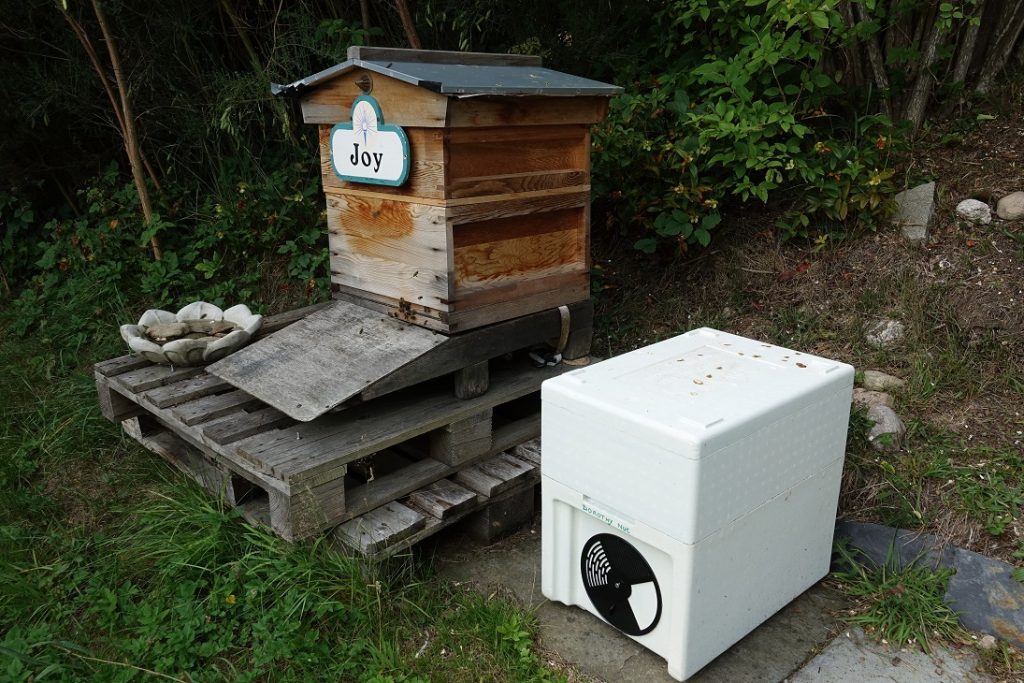
The easiest and most reliable way is to buy a colony, or smaller nucleus (above right), of honey bees from an experienced and trusted local beekeeper who has locally adapted bees for sale. These bees will be suited to the area that you live in, and should be free from disease and have low levels of varroa because the beekeeper is careful and responsible. Often this transaction comes with some support over the first few months, but you should have joined a local beekeeping association and had some training before taking on the responsibility for livestock.
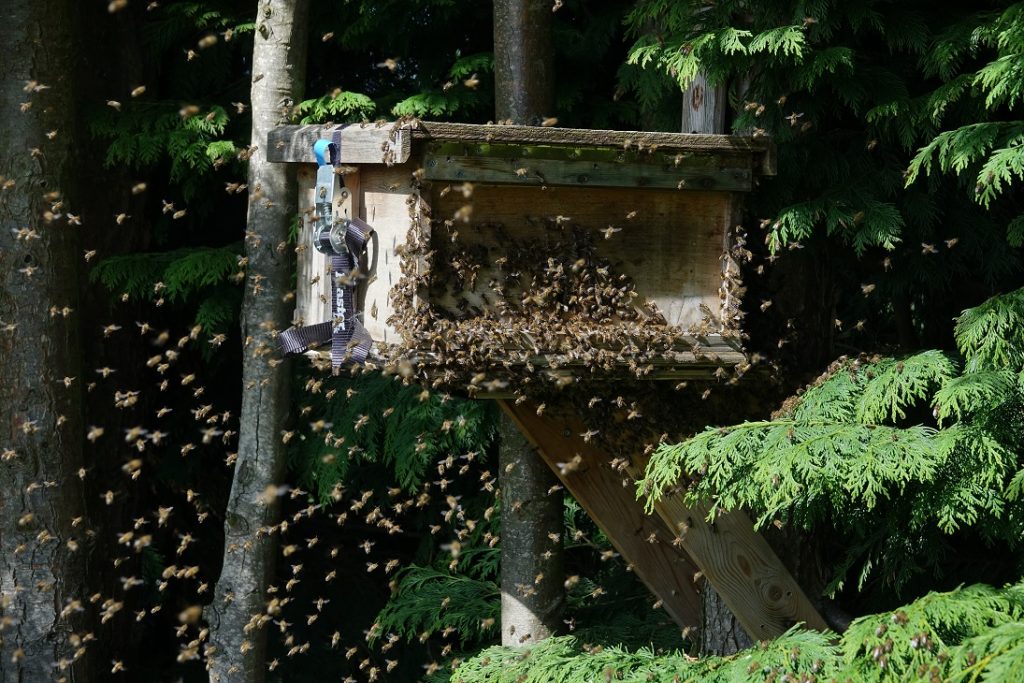
Another way is to get free bees by inviting a swarm into your garden. I set up a bait hive in our garden which has attracted several swarms over the past few years. These swarms have mostly originated from outside my garden apiary but bait hives will attract your own swarms too.
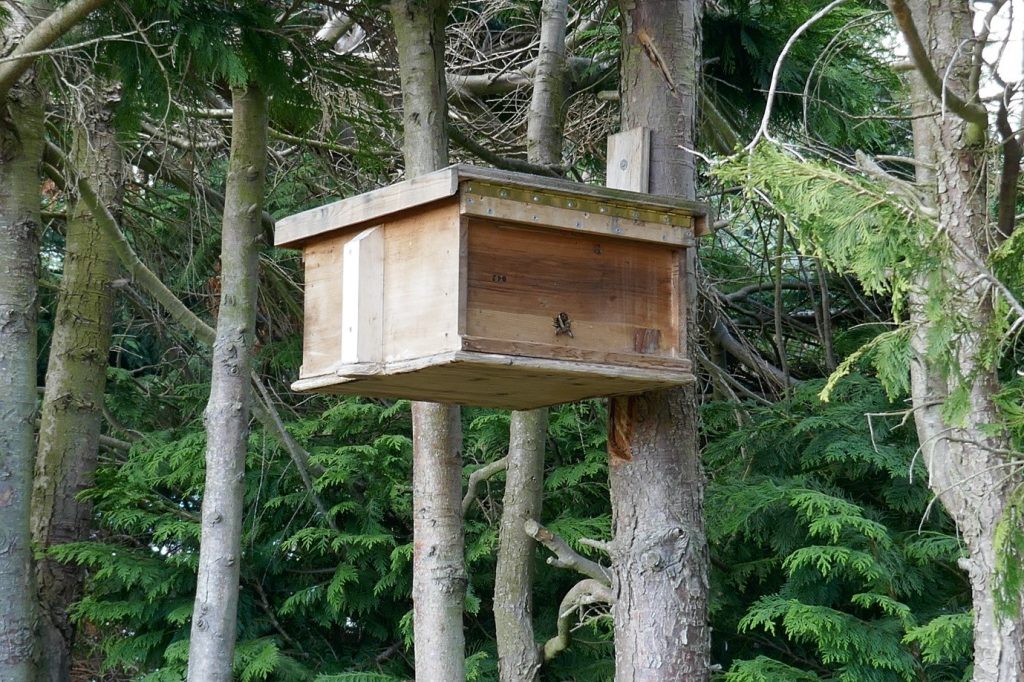
The bait hive above has a knot of scout bees around the entrance and a twig wedged across it. This is because I needed to restrict the entrance to bees and not attract blue tits who might find this an ideal nesting site, albeit a large one!
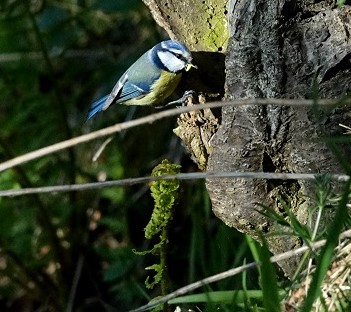
Swarming.
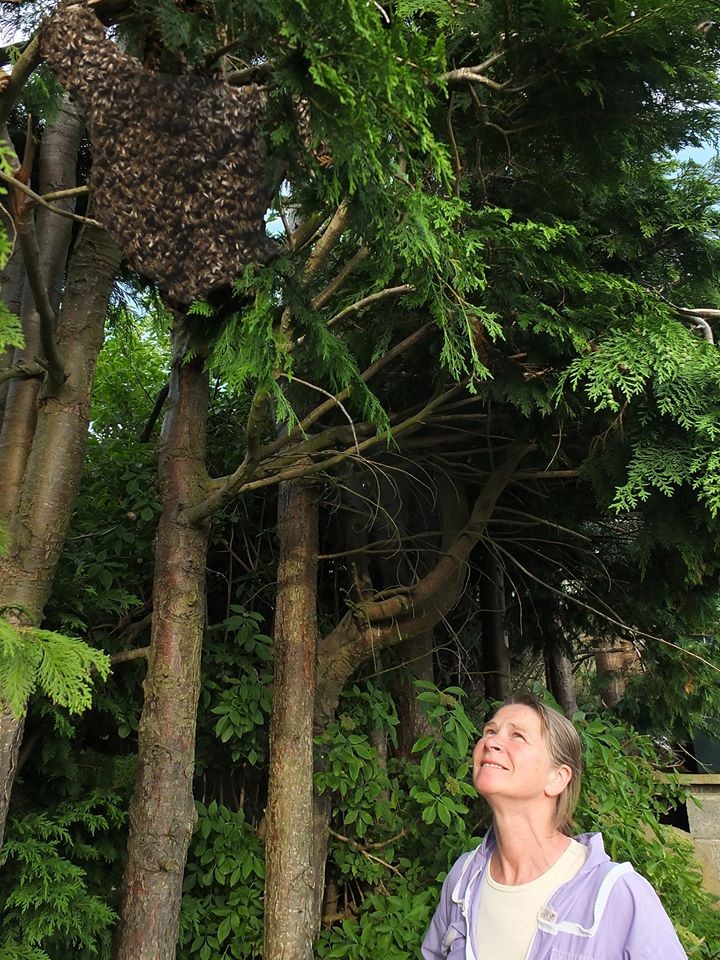
Swarming is one of the main reproductive strategies of honey bees and is what strong healthy colonies want to do in late spring to midsummer, the timing depends on local foraging conditions and your location in the world. Other factors influence swarming which is a natural process with advantages and disadvantages for the beekeeper.
In a nutshell, the hive gets overcrowded and so the old queen leaves with around 10,000 workers bees a high percentage of which are young wax making bees ready to set up a new home and furnish it with wax comb. Scout bees will probably have gone out and about looking for the best new nest site in the area, and their sisters will watch the returning scout bee dancing on the comb back home in the hive. Dancing is also how bees communicate distance and direction to forage sources. On deciding the new home location, they choose it by following and voting for the most vigorous dance which indicates the best location 1. More on ideal homes later since this is key to setting up the bait hive in a good location.
Bee populations naturally increase from around 10,000 at the end of winter to around 40-50, 000 or more at the end of June so that colonies have a strong workforce to gather the nectar available during this period of plenty. The queen releases chemical signals called pheromones which indicate to the workers that she is laying normally, and that all is well. These pheromones promote colony cohesion. However, when the colony becomes crowded with bees the pheromones don’t circulate efficiently and the bees create several queen cells in which to raise new queens—they may think that their queen is no longer working well. Although research cannot yet tell us exactly what triggers swarm preparation, other factors such as no more room for egg laying in the brood frames, and overheating in the hive are thought to influence the swarming urge.
Queen Cells.
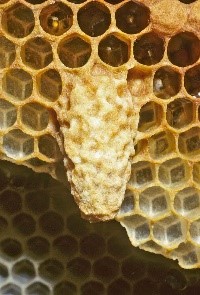
Development.
An egg destined to become a queen is laid in a specially designed cell which will enlarge and hang downwards resembling a peanut in terms of shape and outer texture. The egg hatches on the third day and the queen larva is then fed a special royal jelly diet that makes her different from the worker bee, though both are female begin life as fertilised eggs. The queen larva grows rapidly having been fed copious royal jelly by the nurse bees. On the eighth day, the cell is capped with wax and the larva becomes a pupa feeding on royal jelly stored in the base of the cell. The pupation period is a time of rapid development, and on day sixteen a fully formed virgin queen emerges.
Once a colony has created queen cells the urge to swarm is now so strong, that if the beekeeper knocks down the queen cells to thwart their plans the bees will continue producing more queen cells the moment the beekeeper shuts the hive and goes off for a cuppa.
If all the queen cells are torn down by a beekeeper the bees become desperate and usually create the next queen from an emergency queen cell which may contain a larva that is already a few days old and not adequately nourished by royal jelly. This may produce a second-rate queen which may not serve the colony well. Normally a swarm leaves the hive when the first queen cell is capped on day 8, but if an emergency queen is created from an older two- day old larva the colony can leave three days after the beekeeper last knocked down a queen cell.
Honey Bee Life Cycle.
So, a beekeeper must learn about honey bee life cycle biology and behaviour if swarming is to be managed and a honey crop obtained. One disadvantage of swarming is that it usually occurs during the height of a honey flow and bees will load up with masses of stored honey to transport to the new home leaving the honey supers (boxes where honey is stored by the bees) markedly depleted. Many new workers leave in the swarm so the foraging force of the colony left at home reduces. There may also be the nuisance factor in swarming if neighbours are not happy about having unwanted bees settling in their garden.
Beekeeper Be Aware.
Once I had a phone call from an irate new beekeeper telling me that he had just come back from holiday (in swarm season!) to find that someone had stolen the super full of honey that he’d hoped to harvest. I asked him if he had seen the queen at the last inspection— “NO”. The bees had undoubtedly swarmed but there were still so many bees left behind that the beekeeper figured they couldn’t possibly have swarmed.
Swarm bees prepare for departure by filling up on honey and this is why you lose out on a honey harvest.
Advantages & Disadvantages.
One of the advantages of swarming is that levels of parasitic varroa mite reduce within both the swarm, and the colony left at home to raise a new queen, because they have a break in brood rearing. This means that varroa that breed in the bee brood cell have a break too in raising offspring. However, a swarm landing in your bait hive may be carrying many varroa on the bee bodies so they should be treated for varroa before the queen resumes egg laying. Swarms might carry other diseases too such as foulbrood (European and American) so you really need to know what to look for and have an experienced local beekeeper advise you.
The main disadvantage is losing a honey crop, but if you can also lose more bees in afterswarms or castes if you have not grasped the essentials of swarm management.
Wild Animals.
Honey bees are wild animals and are not regarded as domesticated because we have no control over them or their mating. However, when under the care of a beekeeper they need to be treated as any other livestock, that is; with respect and from a strong knowledge-base perspective. However, as a new beekeeper there is nothing to stop you from catching a swarm and getting help from a local beekeeping association during the season as you learn more about bees.
Bait Hives.
Find out when swarming is likely to occur in your area and set up your bait hives a few weeks in advance. The departure of a swarm takes only five to ten minutes but noticeable preparations begin up to seven, or so, days in advance. I noticed a few scout bees investigating the entrance of my bait hive several days before they actually moved in some days later.
Honey Bee Des Res.
Research by Professor Tom Seeley and colleagues 2 in the 1970’ s shed light for us on the ideal bait hive size based on bee preference:
- Capacity volume: 1.0 to 1.5 cubic feet (30-80 litres). Plenty space for food storage and small enough to keep warm in winter.
- Cavity shape unimportant.
- Entrance area: 1.5 to 2.5 square inches. Easier to defend and enhances thermoregulation.
- Entrance shape: unimportant.
- Entrance position: near the floor assists with thermoregulation.
- Entrance direction: facing south or southwest is preferred, but other directions are acceptable. The direction enhances thermoregulation. Note south facing in Northern hemisphere and north facing in the Antipodes.
- The state of being dry and airtight: Preferable for enhancing thermoregulation but bees can waterproof and block holes with propolis.
- Odour: the odour of beeswax is attractive.
- Height: high entrance off the ground.
Attracting Swarms.
There are commercially available swarm lures that mimic bee pheromones and attract swarms but essential oil of lemongrass works equally well I’ve discovered.
Swarms are attracted by the scent of old combs and some people advocate putting the dirtiest old black comb in a bait hive but I don’t do that because of the risk of spreading disease, and I want the swarm to make clean new comb if possible.
Setting Up The Bait Hive.
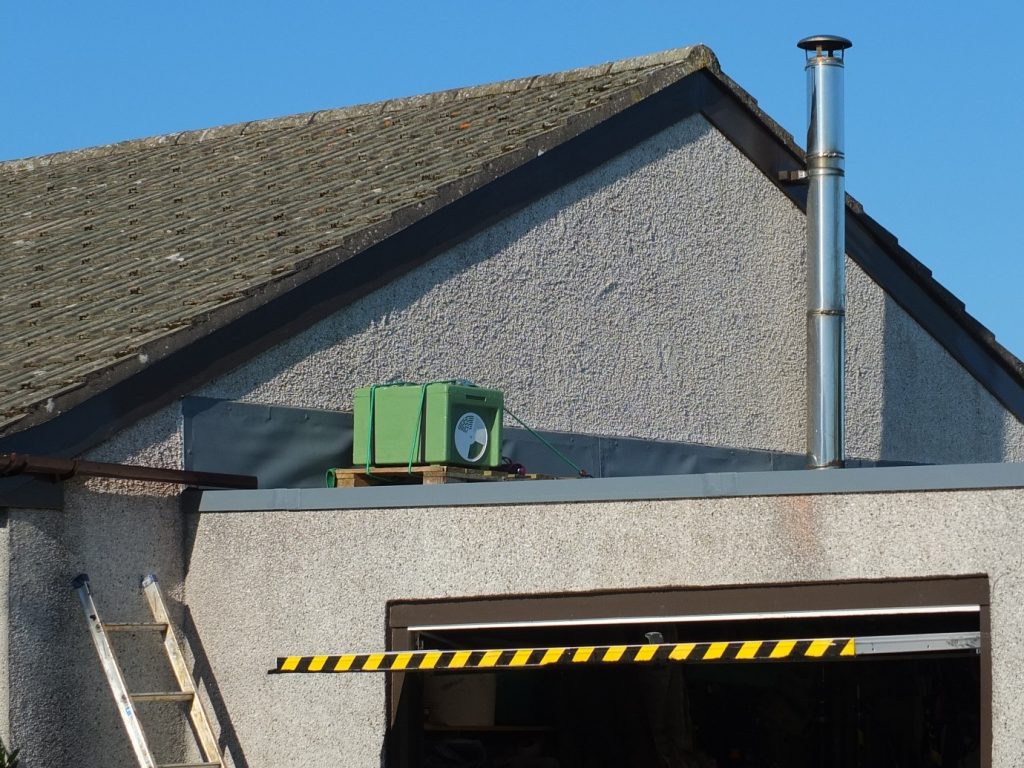
You might build your own bait box. I used the brood box from an old hive with a hinged waterproof lid attached and I positioned it around 6 feet off the ground. Beekeeper safety is key and you do not have to elevate a bait hive in a tree to catch a swarm. They can be placed on the ground. I have also caught swarms in bait hives placed on the ground and these are a lot easier to move around when full of bees. I placed some frames with sheets of foundation interspersed with empty frames containing only starter strips of foundation. The scout bees assess a colony based on capacity and space and are more likely to favour one not full up with frames of drawn- out comb. It is easier to transfer the bees to a new hive if there are on moveable combs that will fit in the hive.
Bait hives need to be well shaded but visible to bees otherwise they may abandon those in the direct sun. Honey bees prefer to nest apart from other colonies so if you already have an apiary, it is good to position bait hives at least 300 feet away if you hope to attract a swarm from your own apiary. On the other hand, beekeepers often finds that swarms move into empty hives left about but not especially intended to be bait hives.
If you didn’t see the swarm arrive but you see a lot of activity at the bait hive entrance, you might have scout bees visiting. Wait till you see worker bees carrying pollen loads on their back legs and then you can be sure that you have a swarm and that the queen is laying again before you move the bait hive.
Removing The Swarm.
To remove the bait hive-swarm you will need protective clothing, smoker, and equipment as you would to handle any hive that you were moving. Work when darkness, cool temperatures or rain have caused all the bees to move inside. If necessary, gently puff smoke at the entrance to coax any lingering bees inside. Use sponge foam and duct tape to close the entrance.
If you need to move the bait hive to another position bear in mind that the swarm will quickly start orientating to that position so you may have to move them three miles or more away for three weeks and then bring them back to your chosen position. Otherwise they may return to the original position of the bait hive if you left them there for several days after they moved in.
For more information on bait hives see Professor Tom Seeley’s previous guest blog. https://www.beelistener.co.uk/bait-hives/guest-blog-tom-seeley-on-bait-hives/
Good luck.
References:
1 Seeley, T.D., 2010. Honeybee Democracy. Princeton University Press.
2 Seeley, T.D., 2012. Using Bait Hives. Bee Culture. April 2012. pp 73-75.
If you enjoyed reading this, you can subscribe to receive future posts by email. Also, if this article helped you with your work, please consider making a small donation to keep our site running.
Thank you, Ann 🐝

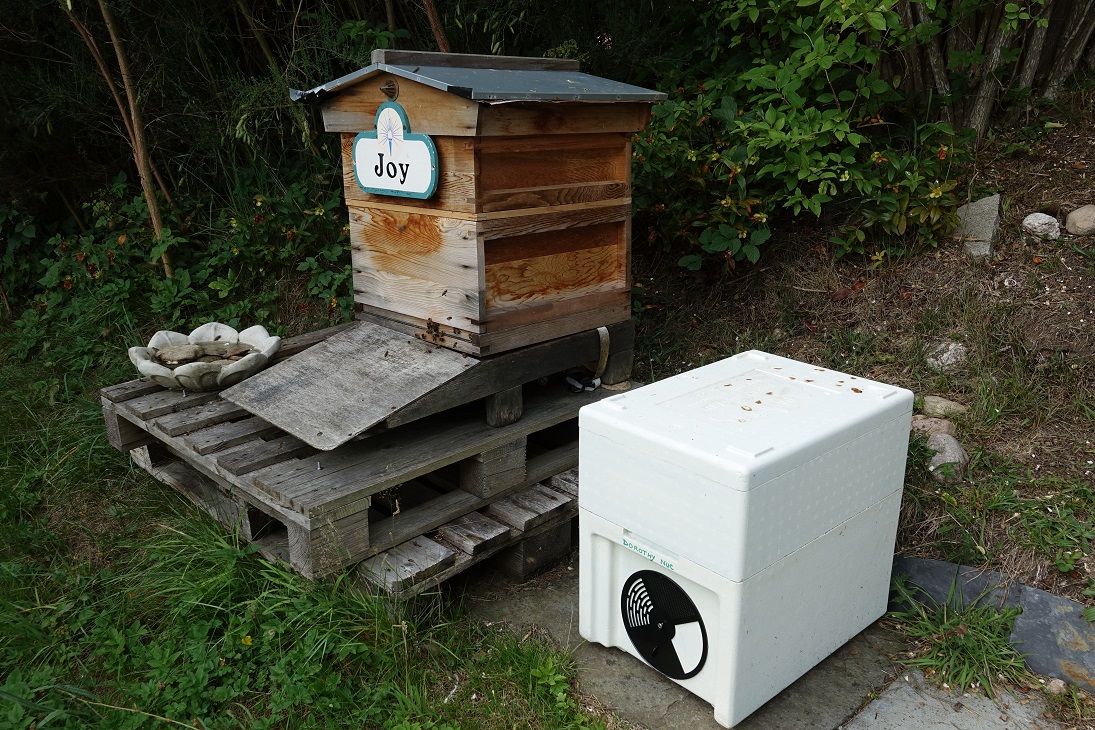
Thank you, Ann, for providing information on how to set up bait hives, and gain swarms without having to dash off to collect them on a moment’s notice. Using them is not only practical, but fun. I’ve being using bait hives since the 1970s, and it still thrills me to find a bait hive come to life by a swarm of bees, from who-knows-where, making it their home.
Hello, Tom. You are the king of bait hives, so, thank you for your postive comments here. Ann.
How do you build a bait hive and what needs to be in it?
Thank you for contributing with good tips. The bees get minerals and salts from water so they actually often collect dirty muddy water.